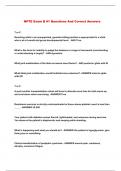Test Bank Microbiology for the Healthcare
vcxx vcxx vcxx vcxx vcxx
Professional
vcxx
3rd Edition vcxx
By Karin C. VanMeter, Robert J. Hubert
vcxx vcxx vcxx vcxx vcxx vcxx vcxx
| Verified Chapter's 1 - 25 | Complete Newest
vcxx vcxx vcxx vcxx vcxx vcxx vcxx vcxx
V
vcxx
er
sio
n
,Table of content vcxx vcxx
1. Scope of microbiology
vcxx vcxx vcxx vcxx
2. Chemistry of life
vcxx vcxx vcxx vcxx
3. Cell structure and function
vcxx vcxx vcxx vcxx vcxx
4. Bacteria and archaea
vcxx vcxx vcxx vcxx
5. Viruses
vcxx vcxx
6. Eukaryotic microorganisms
vcxx vcxx vcxx
7. Physical and chemical methods of control
vcxx vcxx vcxx vcxx vcxx vcxx vcxx
8. Microbiological laboratory techniques
vcxx vcxx vcxx vcxx
9. Microbiological laboratory safety issues
vcxx vcxx vcxx vcxx vcxx
10. vcxx vcxxPharmacology
11. vcxx vcxxAntimicrobial drugs vcxx
12. vcxx vcxxInfection and disease vcxx vcxx
13. vcxx vcxxThe immune response and lymphatic system
vcxx vcxx vcxx vcxx vcxx
14. vcxx vcxxInfections of the integumentary system, soft tissue, and musculoskeletal
vcxx vcxx vcxx vcxx vcxx vcxx vcxx vcxx
system
vcxx
15. vcxx vcxxInfections of the respiratory system
vcxx vcxx vcxx vcxx
16. vcxx vcxxInfections of the gastrointestinal system
vcxx vcxx vcxx vcxx
vcxx 17. Infections of the nervous system and sensory structures
vcxx vcxx vcxx vcxx vcxx vcxx vcxx vcxx vcxx
vcxx 18. Infections of the cardiovascular and circulatory systems
vcxx vcxx vcxx vcxx vcxx vcxx vcxx vcxx
vcxx 19. Infections of the urinary system
vcxx vcxx vcxx vcxx vcxx vcxx
20. vcxx vcxxInfections of the reproductive system
vcxx vcxx vcxx vcxx
vcxx 21. Sexually transmitted infections and diseases
vcxx vcxx vcxx vcxx vcxx vcxx
22. vcxx vcxxHuman age and microorganisms
vcxx vcxx vcxx
vcxx 23. Microorganisms in the environment and effects on human health
vcxx vcxx vcxx vcxx vcxx vcxx vcxx vcxx vcxx vcxx
24. vcxx vcxxEmerging infectious diseases vcxx vcxx
25. vcxx vcxxBiotechnology
,Chapter 01: Scope of Microbiology
vcxx vcxx vcxx vcxx
VanMeter: Microbiology for the Healthcare Professional, 3rd Edition
vcxx vcxx vcxx vcxx vcxx vcxx vcxx
MULTIPLE vcxxCHOICE
1. In vcxxthe vcxxsixteenth vcxxcentury vcxxa vcxxfather-and-son vcxxteam, vcxxby vcxxthe vcxxname vcxxof ,
produced vcxxavcxcompound vcxxmicroscope vcxxconsisting vcxxof vcxxa vcxxsimple vcxxtube vcxxwith
vcxx
vcxxlenses vcxxat vcxxeach vcxxend.
a. van vcxxLeeuwenhoek
b. Semmelweis
c. Janssen
d. Hooke
ANS: v c x x C REF: v c x x p. vcxx3
2. “Animalcules” vcxxwere vcxxfirst vcxxdescribed vcxxby
a. Robert vcxxHooke.
b. Antony vcxxvan vcxxLeeuwenhoek.
c. Hans vcxxJanssen.
d. John vcxxNeedham.
ANS: v c x x B REF: v c x x p. vcxx3
3. Micrographia, vcxxa vcxxpublication vcxxillustrating vcxxinsects, vcxxsponges, vcxxas vcxxwell vcxxas vcxxplant vcxxcells,
vcxx was vcxxpublishedvcxby
a. Robert vcxxHooke.
b. Antony vcxxvan vcxxLeeuwenhoek.
c. Hans vcxxJanssen.
d. John vcxxNeedham.
ANS: v c x x A REF: v c x x p. vcxx3
4. Low-power vcxxmicroscopes vcxxdesigned vcxxfor vcxxobserving vcxxfairly vcxxlarge vcxxobjects vcxxsuch vcxxas
vcxx insects vcxxor vcxxwormsvcxare
a. electron vcxxmicroscopes.
b. dark-field vcxxmicroscopes.
c. fluorescence vcxxmicroscopes.
d. stereomicroscopes.
ANS: v c x x D REF: v c x x p. vcxx5
5. A vcxxmicroscope vcxxthat vcxxprovides vcxxa vcxxthree-dimensional vcxximage vcxxof vcxxa vcxxspecimen vcxxis vcxxa
a. dark-field vcxxmicroscope.
b. transmission vcxxelectron vcxxmicroscope.
c. bright-field vcxxmicroscope.
d. scanning vcxxelectron vcxxmicroscope.
ANS: v c x x D REF: v c x x p. vcxx7
6. The vcxxtool vcxxof vcxxchoice vcxxto vcxxobserve vcxxliving vcxxmicroorganisms vcxxis vcxxthe
a. bright-field vcxxmicroscope.
b. phase-contrast vcxxmicroscope.
, c. fluorescence vcxxmicroscope.
d. electron vcxxmicroscope.
ANS: v c x x B REF: v c x x p. vcxx6
7. Which vcxxscientist vcxxis vcxxmost vcxxresponsible vcxxfor vcxxending vcxxthe vcxxcontroversy vcxxabout vcxxspontaneous
generation?
vcxx
a. John vcxxNeedham
b. Joseph vcxxLister
c. Louis vcxxPasteur
d. Robert vcxxKoch
ANS: v c x x C REF: v c x x p. vcxx8
8. Fossils vcxxof vcxxprokaryotes vcxxgo vcxxback billion vcxxyears.
a. 4.0 vcxxto vcxx5.0
b. vcxx vcxx v c x x 3.5 vcxxto vcxx4.0
c. 2.5 vcxxto vcxx3.0
d. vcxx vcxx v c x x 2.2 vcxxto vcxx2.7
ANS: v c x x B REF: v c x x p. vcxx9
9. Molds vcxxbelong vcxxto vcxxwhich vcxxof vcxxthe vcxxfollowing vcxxgroups vcxxof vcxxeukaryotic vcxxorganisms?
a. Protozoans
b. Archaea
c. Fungi
d. Algae
ANS: v c x x C REF: v c x x p. vcxx11
10. The vcxxcorrect vcxxdescending vcxxorder vcxxof vcxxtaxonomic vcxxcategories vcxxis
a. species, vcxxdomain, vcxxphylum, vcxxkingdom, vcxxorder, vcxxdivision, vcxxclass, vcxxgenus.
b. domain, vcxxkingdom, vcxxphylum, vcxxclass, vcxxfamily, vcxxorder, vcxxgenus, vcxxspecies.
c. domain, vcxxkingdom, vcxxphylum, vcxxclass, vcxxorder, vcxxfamily, vcxxgenus, vcxxspecies.
d. kingdom, vcxxdomain, vcxxphylum, vcxxorder, vcxxclass, vcxxfamily, vcxxgenus, vcxxspecies.
ANS: v c x x C REF: v c x x p. vcxx10
11. Complex vcxxcommunities vcxxof vcxxmicroorganisms vcxxon vcxxsurfaces vcxxare vcxxcalled
a. colonies.
b. biofilms.
c. biospheres.
d. flora.
ANS: v c x x B REF: v c x x p. vcxx12
12. A vcxxrelationship vcxxbetween vcxxorganisms vcxxin vcxxwhich vcxxthe vcxxwaste vcxxproduct vcxxof vcxxone
provides vcxxnutrients vcxxforvcxanother vcxxis vcxxcalled
vcxx
a. mutualism.
b. competition.
c. synergism.
d. commensalism.
ANS: v c x x D REF: v c x x p. vcxx12





